* (Halloween countdown post #2)
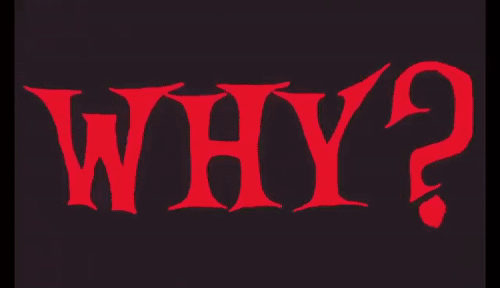
‘Terence Fisher’s critical reputation rests almost entirely on the horror films he directed for Hammer in the 1950s and 1960s, but he was a more versatile filmmaker than his horror output suggests. Born in London on 23 February 1904, he served in the Merchant Navy before entering the film industry in 1933. From 1936 to 1947 he worked as a film editor for a variety of production companies, with his best-known project probably the Gainsborough melodrama The Wicked Lady (d. Leslie Arliss, 1945). His first three films as director – Colonel Bogey (1947), To the Public Danger and Song for Tomorrow (both 1948) – were short dramas produced at Highbury Studio, which was being used by the Rank Organisation to develop new talent. To the Public Danger, an impressively staged adaptation of a Patrick Hamilton radio play, was the best of these, and some critics have retrospectively seen it as anticipating Fisher’s later horror work. As a further sign of things to come, future Hammer star Christopher Lee made a brief appearance in Song for Tomorrow.
‘After Highbury, Fisher moved to Gainsborough where he directed (or co-directed with Antony Darnborough) four feature films. As with To the Public Danger, horror critics have identified the period mystery drama So Long at the Fair (1950), Fisher’s final Gainsborough film, as a horror-like project. But Fisher’s other Gainsborough films reveal him to be a talented director adept at a range of subjects – the plight of post-war refugees in Portrait from Life, tragic romance in the Noël Coward vehicle The Astonished Heart (1949) and light comedy in the portmanteau drama Marry Me! (1949).
‘When Gainsborough closed in the early 1950s, Fisher became a prolific specialist in the low-budget support feature that was becoming an increasingly important aspect of British film production. None of these films, nineteen in total, were strikingly original but some of them – notably the melodrama Stolen Face (1952) and the SF drama Four-Sided Triangle (1953) – contained flashes of talent and ambition. Eleven of these films were made for Hammer, an up-and-coming independent production company with which Fisher’s future career would become inextricably linked. When Hammer decided in the mid-1950s to remodel itself as a horror factory, Fisher became its main director. He was part of the team that produced all the ‘classic’ Hammer horrors – including The Curse of Frankenstein (1957), Dracula (1958), The Mummy (1959), The Hound of the Baskervilles (1959) and The Curse of the Werewolf (1961) – and his measured and stately style was a key aspect of the Hammer formula.
‘Given the low budgets involved and the breakneck production schedules, the quality of these films was inevitably uneven, but some of them, and especially Dracula, were remarkable achievements, albeit ones that were not generally feted by critics at the time of their initial appearance. After the box-office failure of The Phantom of the Opera (1962), Fisher worked less often for Hammer, although his later Hammer films arguably comprise his best work, reflecting as they do both a technical maturity and a willingness to innovate. Although Fisher is regularly accused of representing a conservative moralistic force within British horror, films like Frankenstein Created Woman (1967) and The Devil Rides Out (1968) show a tentative and questioning attitude to social authority and morality.
‘Fisher’s other films from the 1960s – the SF invasion fantasies The Earth Dies Screaming (1964), Island of Terror (1966) and Night of the Big Heat (1967), and a German-produced Sherlock Holmes story – are less successful although interesting nevertheless. Fisher’s final film, the Hammer production Frankenstein and the Monster from Hell, was completed in 1972 (although not released until 1974).
‘Fisher received very little critical attention throughout his career. Ironically, as that career ended, the publication in 1973 of A Heritage of Horror, David Pirie’s book-length study of the British horror film, led to a re-appraisal of his work. Since that time, Fisher has come to be seen as a major British film director, especially so far as his horror films are concerned, and as someone who embodies the virtues of a popular British genre cinema. It is still the case, however, that Fisher’s pre-horror work has not received the critical attention it merits. Terence Fisher died on 18 June 1980.’ — screen online
____
Stills
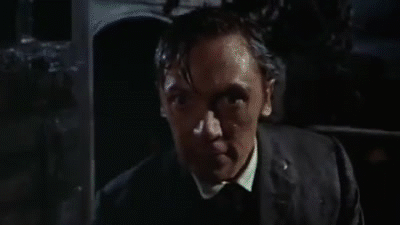

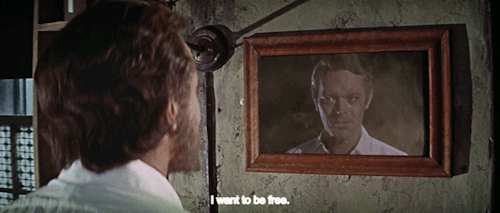
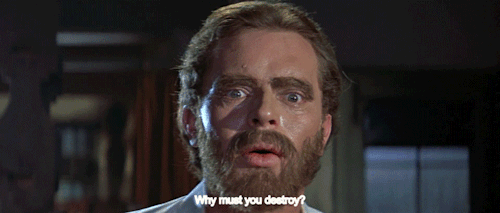

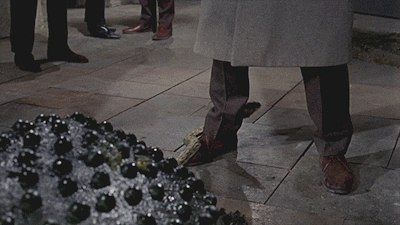
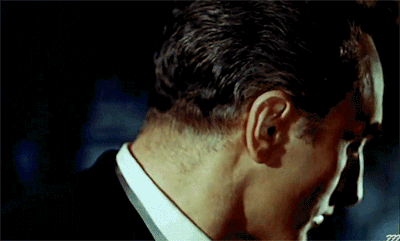
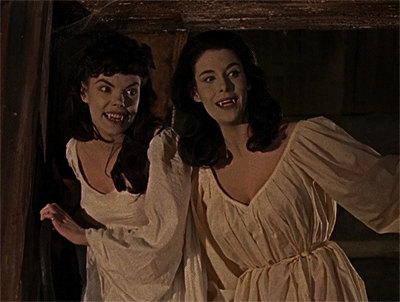
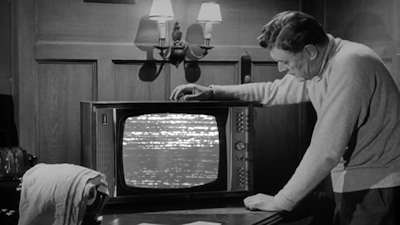
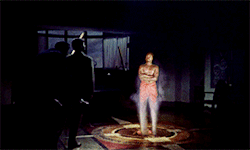
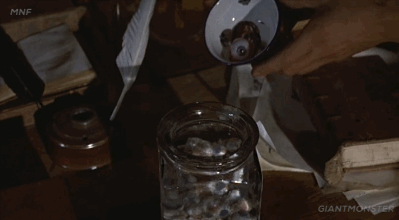
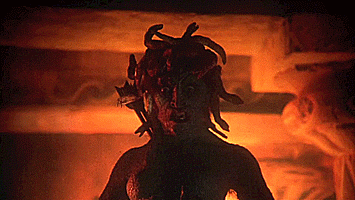
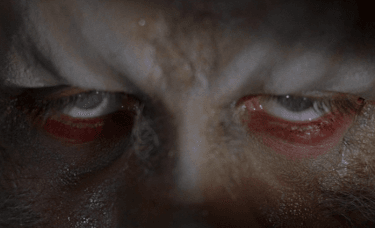

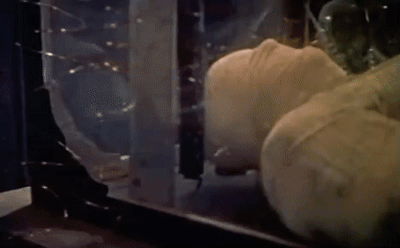

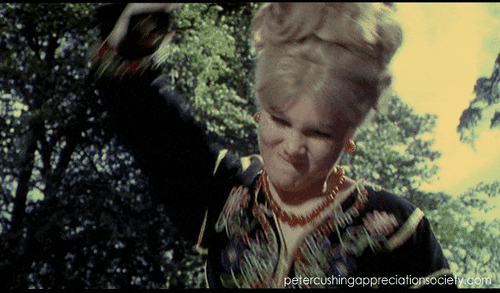

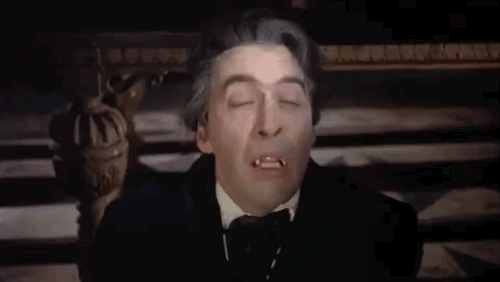

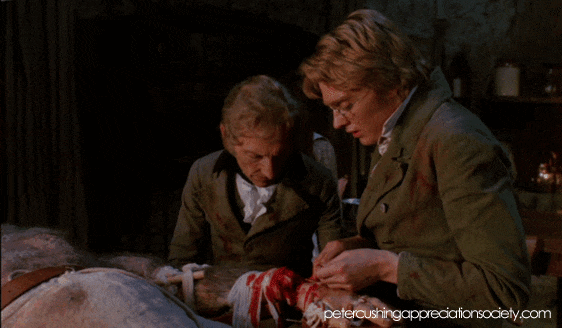


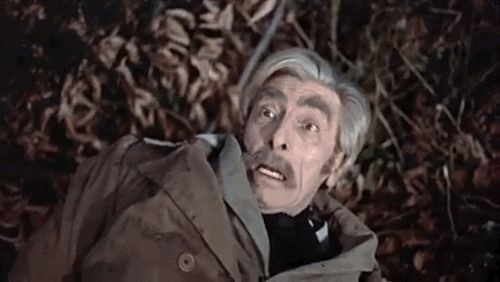











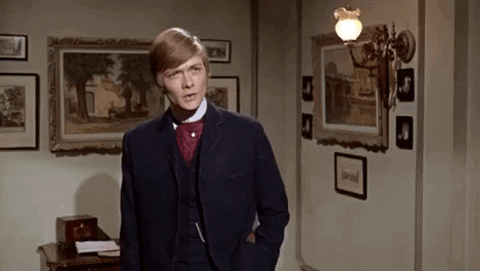



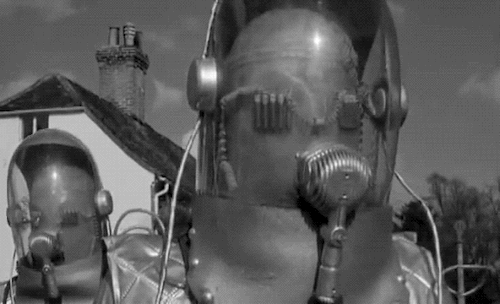
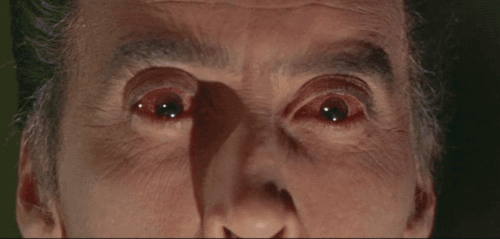


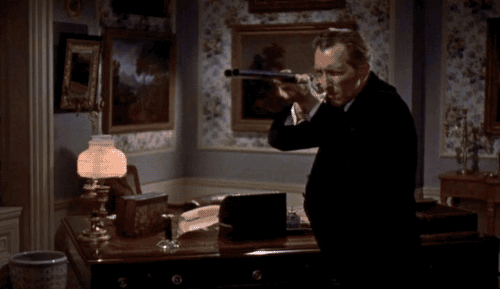
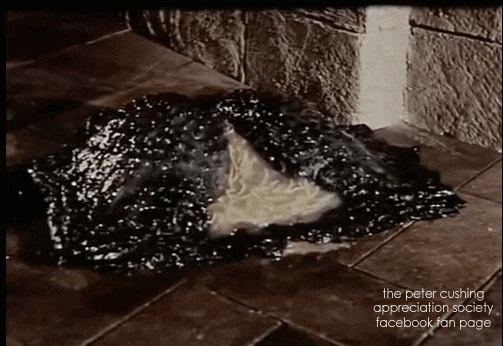
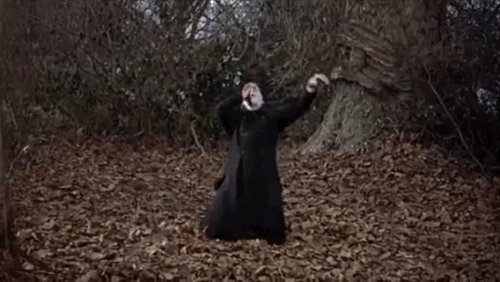
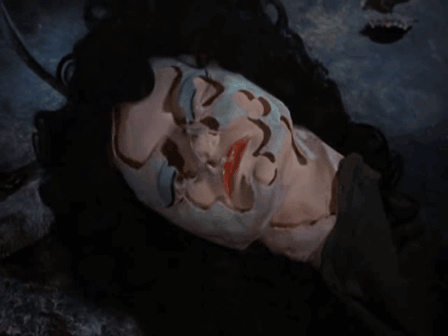
____
Further
Terence Fisher @ IMDb
Terence Fisher, Hammer’s Horror Maestro – A Biography
Les meilleurs films de Terence Fisher
Lumière ! Réalisateurs : Terence Fisher
Book: The Films of Terence Fisher: Hammer Horror and Beyond
Terence Fisher Fan Page @ Facebook
TERENCE FISHER INTERVIEW: AN AFTERNOON IN “HOLLY COTTAGE”
The Cross and the Vampire: Religious Themes in Terence Fisher’s Hammer Horrors
Terence Fisher @ TSPDT
Book: Terence Fisher, by Peter Hutchings
Terence Fisher: Horror, Myth and Religion
Terence Fisher @ letterboxd
Terence Fisher, le roi de la Hammer
Situation historico-fantastique du château dans l’œuvre de Terence Fisher
DIRECTORS CUTS: TOP 7 FILMS BY HAMMER’S MAESTRO TERENCE FISHER
TERENCE FISHER – ACTERIEUR DU CINEMA
Terence Fisher and science fiction
____
Extras
Terence Fisher – Films Posters Collection
Terreur et Glamour: Montée et Déclin du Studio Hammer
____
Interview
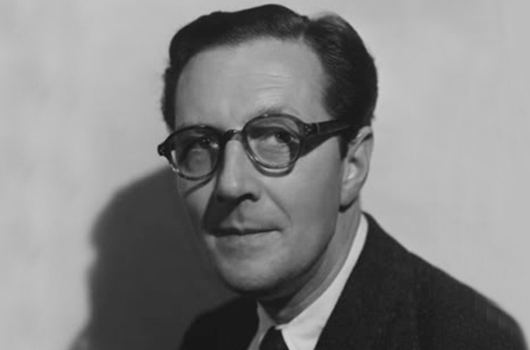
JVG: Before you became a director, you’ve worked as an editor for quite some time. You have often said that the cutting of a film is very important. Were you yourself deeply involved in the cutting of your own films?
Terence Fisher: I’ve always worked closely with the editor after the film was finished. But I don’t think I gave him as much material as most directors do. When I was working in the cutting room as an editor, I learned to cut in the camera. I was a good film editor and consequently I don’t have to waste time on shooting extraneous cover shots which I wouldn’t need in the end anyway. The film always jigsawed together without any pieces left over. We were never left at the end with one picture and three bits, or even more than three. I shoot to an average of footage of 3½-4 to 1. If you’re working on a moderate budget, anything counts that appears to be a waste. Every shot I ever did was used. Unless of course one ran over the maximum length of the film and wanted to reduce the time by cutting a whole scene, or a sequence, or half a sequence. But in the first complete edition of the film everything we had shot on the floor was in the film.
JVG: Your editors had an easy job then, they were just continuity editors.
TF: That is exaggerating it a little bit of course. You still have to intercut and cut in close shots and so on. Their choice comes in when they have to intercut a conversation between different characters. You are never quite sure in that situation, but you do know how you build up to that situation and how you come out of it. I didn’t supply the cutting room with a lot of wasted material. I cut quite largely in the camera. Basically I cut in the shape of a scene, but when one gets into close shots, showing the emotional reactions of the characters involved in a certain situation, one has to get the full emotional impact of that situation. The whole basis for cutting emotional scenes is reaction rather than action. Generally speaking it is more important to see the effect of a particular spoken word upon the person who’s listening, rather than upon the person who is expressing. If you sit in a theater and see a stage play in whole – in one long shot, to use the film expression – the audience’s attention is more fixed upon one person than another person and another person and another person, according to the development of the scene and what is said. I don’t think the audience is hypnotized by the person who is speaking. I think they automatically go to see the reaction of the character who is listening. I’ve tried to analyze this after I’d been to the theater occasionally, how my attention switched in that respect in certain scenes. But it is too difficult to remember afterwards, because one gets emotionally carried away and your emotion shows you what it wants you to see. You can’t remember afterwards which person caught your eye’s attention, the person who’s speaking or the person who’s listening. Maybe different people have different reactions. This is interesting to analyze. Maybe some people will always be more interested in and fascinated by the person who’s speaking, I don’t know. This may also vary according to the make-up the person is wearing. What is your opinion about this?
JVG: I don’t know, really… I think it will largely depend on the situation…
TF: This is the whole basis of cutting, whether it concerns close-ups in conversation or highly dramatic action scenes.
AF: It’s what you say and what’s been said to you, what makes the reactions rather than the words themselves.
TF: Yes, that’s right.
JVG: You have often worked with Bernard Robinson. He designed most of your Hammer films. You liked him very much…
TF: Tremendously! I liked him very much personally and professionally. He had a great feel for the emotional impact of a subject. One always knew in his sets what was going to happen. He was uncanny in knowing that you would need a certain kind of window design or wall or something at a particular place. He would know exactly where a certain action would take place, and he would give you a background which went well with the emotional impact of that scene. He had a great feeling for his work.
AF: Would you say that his use of the twisted pillars, which appear in most of his sets, were really designed to make you feel uneasy?
TF: Yes. I think so. because he used them right from the start. They gave a peculiar effect.
GP: Roger Corman also used them in some of his later films…
TF: I should think Bernie started the fashion. I’m sure he did.
JVG: The lighting and photography are of course also very important in your films… What exactly is everybody’s function in that respect when you are directing? Of the camera operator, the director of photography, you yourself…
TF: In England directors of photography don’t want to interfere with their operators, as they do on the continent. Continental directors of photography want to have more control over their operators than they do in England. It can work both ways, but I think it’s easier for a film director to work with the camera operator, without actually interfering. But let’s take the director of photography, or let’s call him lighting camera man. You’ve got to leave his style to him. Different lighting camera men have different styles of working. Within each one’s style you can get a certain type of mood if you tell him what you’re aiming at. If you want for instance an actor not to be seen in features but in silhouette, you tell him so. In the first rehearsal he will work from that. Then again it is a co-operative thing between the director and the lighting camera man. But you can’t tell him to change his style. Each lighting camera man has his own individual style. Jack Asher, who did the early Hammer ones, had a very distinctive style of lighting, which was quite different to Arthur Grant’s. He had a more realistic approach to the situation. Jack Asher’s was almost theatrical lighting with little tricks, like color slides placed over the lights and so on.
JVG: I think Jack Asher was also very emotional…
TF: Oh indeed he was. Indeed…
JVG: Much more so than Arthur Grant…
TF: Arthur Grant approached it with a more realistic interpretation. But Arthur would give you a good job if you told him what you were aiming at. If you asked him not to see people’s features and to do it with back-lighting, which is very important at certain moments within the field, he could give you almost theatrical lighting like Jack Asher did. Which of the two is the best I don’t know. I don’t know exactly how audiences react to this.
AF: They shouldn’t react at all on a conscious level.
TF: No, but it must be affecting them, one way or another, although they wouldn’t know why.
AF: The use of your exteriors was totally against the norms of the time. That was very much your own personal signature rather than say Jack Asher’s or Arthur Grant’s.
TF: Yes, that is correct.
JVG: Do you work close to the camera operator?
TF: Yes, very closely, shot by shot, where the camera should be at any given moment, when and how it should be moved. All this we work out together. The camera is the instrument for translating the script into a visual form.
JVG: In the early reviews of your films, you were very wrongfully criticized for not moving your camera often, for being “static” or even “pedestrian”, while on the contrary your plenty camera movements are very intricate and laborious, but probably so much in accordance with the action, that they remain unnoticed by the audience and the critics.
TF: I strongly believe that there always has to be a reason for moving your camera, or for changing an angle. You can’t move or change, just because you are bored with your angle. But I do move my camera! People who say that are maybe not conscious of it being moved all the time. If they would take the trouble to sit down and count how many times the camera moves, they’d be staggered. In a straight viewing you would not, and you should not be conscious of that movement. Unless I want you to be conscious of it, when it has a dramatic impact. A lot of people have misguided ideas in that respect. For me there has to be a definite reason, a logical or emotional and dramatic reason, for changing the position of your camera or for moving it. It could even be a movement for the sake of convenience, provided the audience is not conscious of it, if it does not intrude into the dramatic content of what you are showing. You can find all sorts of tricks for moving your camera. One of the simplest tricks in the world is to follow a side character. Take for instance a night club or a restaurant scene, where you want to show the whole thing and end up at a particular table with people in conversation. The simplest way to give a reason for moving your camera is by having a waiter enter from anywhere with a serving tray. He is moving towards the table you want to get into the frame. The camera goes round with him, showing the interior, and will end up precisely where you want to have it. The audience will accept this movement of the camera as natural, because it has been taken there by the waiter, for a reason. It’s a simple trick. And there are many ways of doing it.
JVG: Do you look through the view-finder yourself?
TF: I know lenses pretty well. I used to look a lot through the view-finder in the early days, but only very quickly, just to see the effect. After a short time one gets to know the different distances and all other things.
JVG: Did you use many trick lenses?
TF: I didn’t. Only when there was a definite reason to use one.
JVG: In THE CURSE OF THE WEREWOLF, you used the zoom lens for the first time. Later you said you weren’t too happy with the result.
TF: When the zoom lens first came into use, people were mesmerized by it and misused it completely. The zoom is very useful and can get you out of an awful lot of tracking. Instead of tracking you can use a slow zoom, which is the same thing, but you avoid having to lay tracks on exteriors and sometimes even on interiors, which is very expensive. You can also combine a tracking with a zoom and make the camera move physically in a way you couldn’t possibly do on tracks alone. [Many marvellous examples of this technique became one of Terence Fisher’s trademarks.] These are ways to use the zoom intelligently. Today’s zoom lenses are perfected up to the point where you have full control over the speed. In the early days you didn’t have that control, it was a somewhat haphazard thing technically. If it is under control, however, it can give you a tremendous advantage, provided it is used properly. It is far less expensive than a travelling. There still is a slight difference between a zoom and a travelling because with a travelling you move your camera towards the subject and with a zoom you pull the subject towards your camera. It gives a different psychological effect, but the distinction is very subtle.
JVG: In fact, you don’t hold anything really against the way you used the zoom lens in THE CURSE OF THE WEREWOLF, as one could conclude from the interview you gave to “Midi-Minuit Fantastique” about ten years ago?
TF: No, certainly not. Those people must have misinterpreted a lot of what I said in those interviews. I was not abusing the zoom lens but the misuse of it. I think it is a wonderful technical achievement. To misuse it, like the misuse of any other technical aid, is foolish. But you use anything technically that will help dramatically and if there is a reason for it.
JVG: When you discuss a film with your actors, do you seriously consider their suggestions?
TF: Of course, very much so. They are vital to consult. Many things come out of what we call the first rehearsal, the rough run-through. That is when you find out what the actors are going to bring to the film. Although you will also discuss the content and the line of direction on the set, that first rehearsal is the most exciting thing. Little twists and variations come in which no director could think of, but which an actor, who is really living the character he is to play, will bring in. Like how the characters will react under certain circumstances… how he reacts, what he does, what he says. You would never have thought of these things yourself, no director would. Many directors are rather definite about what they expect, they lay down the rules before the first rehearsal. I think that is ridiculous, because it is then when those impromptu things come from an actor who is really living the character he is supposed to portray. No director could think of these things. He could think of something else of course, but it wouldn’t be nearly as good or in the wrong place. I love that first run-through, the spontaneous expression of what the actor feels without too many preconceived ideas. And here we come again to this question of the intuitiveness of filmmaking…
AF: From what you say now, an actor is probably the least obvious person to direct a film…
TF: Indeed. I don’t think that any actor is, with that one great exception. Orson Welles is a tremendous actor and a tremendous director as well.
JVG: Do you think a film could be ruined by an actor who is miscast or who is not giving his best.
TF: Yes, in various degrees…
JVG: Don’t you think a director could still make something out of it?
TF: Well, he could make something out of it, but not what he should make out of it. Please. Bad casting is a tragedy, isn’t it.
JVG: Yes… On the contrary, do you think that when you have a bad script but a very good cast, you could still make a good film.
TF: No… One could make a better film, yes, but not a good one.
JVG: But better because of the actors?
TF: Yes, because of the actors. In what degree the actor will affect the film, for better or worse, is very hard to tell. That depends so much on the size of that actor’s talent and on the content. You can’t sit on the back of his neck all of the time, can you. You have to believe, with the actor, in the particular part he is portraying. It’s a bit of life, isn’t it. He’s got to emotionally portray to the audience. That’s communication again. The audience has got to believe in him as long as they’re looking. I don’t care much for what they say afterwards, but during those two hours they got to believe the whole thing. It’s like hypnotism really. They got to believe what they see, they got to move emotionally into the action.
JVG: You have worked with an incredible number of famous actors in your carreer. I’ve got an impressive list here of actors you worked with. It includes Dirk Bogarde, Mai Zetterling, Noel Coward, Oliver Reed, Jean Simmons, Eva Bartok, and so on and on, too many to name. You must have been directing every good actor in this country at one time or another…
TF: Yes… I hadn’t realized it so much until Alan here reminded me the other day and started reading all the names of the people I worked with. That’s a lovely thing, isn’t it.
JVG: Yes, indeed it is.
TF: It’s a most exciting idea…
_____________
17 of Terence Fisher’s 64 films
_____________
Frankenstein and the Monster from Hell (1974)
‘Frankenstein and the Monster From Hell is a 1974 British film directed by Terence Fisher and produced by Hammer Film Productions. It stars Peter Cushing, Shane Briant and David Prowse. Filmed at Elstree Studio] in 1972 but not released until 1974, it is the final chapter in the Hammer Frankenstein saga of films as well as director Fisher’s last film.’ — horror.fandom
Trailer
Excerpt
______________
Frankenstein Must Be Destroyed (1969)
‘The key image of this film occurs early on, as a hideous monster removes its face, only to reveal itself as Baron Frankenstein in a mask. Hammer’s fifth installment in the series sees the transformation of doctor into monster complete. Peter Cushing’s portrayal of the Baron here is all insanity and hatred, rather than the misunderstood (if unethical) genius of previous entries. Frankenstein transplants the brain of an insane doctor into Freddie Jones’ body, creating a pathetic, misshapen beast, while using blackmail and rape to control the people around him. This was director Terence Fisher’s favorite film, and his pacing and composition have rarely been better. Jones (the nasty showman in The Elephant Man) is great at communicating the disorientation and helpless agony of his condition, and while Cushing’s character is more one-dimensional than usual, he does his normal excellent job as the Baron. Hammer’s next installment was the silly Horror of Frankenstein before Fisher returned to end the series with Frankenstein and the Monster from Hell.’ — RT
Trailer
Excerpt
_____________
The Devil Rides Out (1968)
‘In Rosemary’s Baby, Roman Polanski builds the suspense by cloaking the evil in dark hallucinogenic dreams. Terence Fisher brings the frights to The Devil Rides Out by concentrating on the minutiae of the workings of black magic. Both films were made in 1967, the year of the first publicized Satanic baptism in history, when three-year-old Zeena Schreck, now a tantric Buddhist yogini, heralded the summer of love. The same year as The Rolling Stones’ sympathetic album Their Satanic Majesty’s Request and The Beatles’ Sergeant Pepper’s Lonely Hearts Club Band, almost twenty years, to the day, that the man who brought new parts to play, Aleister Crowley, died.’ — Tony Sokol
the entirety
______________
Island of the Burning Damned (1967)
‘While mainland Britain shivers in deepest winter, the northern island of Fara bakes in the nineties, and the boys at the Met station have no more idea what is going on than the regulars at the Swan. Only a stand-offish visting scientist realizes space aliens are to blame.’ — The Movie DB
Trailer
_______________
Frankenstein Created Woman (1967)
‘In this “most conceptually wild and outrightly science-fictional of the Hammer Frankenstein films”, Baron Frankenstein (Peter Cushing) and Dr. Hertz (Thorley Walters) are embarking upon an experiment to capture the souls of the dead and impose them into other bodies. When their assistant, Hans (Robert Morris), is unjustly accused of murdering his girlfriend Christina’s father and is himself put to death, the two men claim his body and trap his soul in their laboratory. Meanwhile, Christina (Susan Denberg) is consumed with grief over the death of her beloved Hans and commits suicide.’ — SHOUT
Trailer
________________
Island of Terror (1966)
‘Success invariably leads to imitation. With all the attention (and box office grosses) Hammer Film Productions was attracting in the 1960’s, it was inevitable that Hammer wannabes would start sprouting up like mushrooms from the loamy, light-starved soil of the English movie industry. Amicus and Tigon are probably the best known of the Hammer clones, but there were other studios out there playing Monogram to Hammer’s Universal. One of the most utterly forgotten was Planet Film Productions, the studio responsible for bringing us Island of Terror/Night of the Silicates/etc. The amazing thing about Planet was that they were able to pull off the very same trick as their richer, higher-prestige competitors, and dip into the Hammer talent pool. Amicus you expect to be able to pay Peter Cushing’s or Terrence Fisher’s price; a little fly-by-night operation like this is another matter altogether. And almost equally remarkable is the particular aspect of Hammer that Planet chose to copy— rather than producing knockoffs of the somewhat sensationalized gothics that Hammer is best remembered for today, Planet’s stock in trade (at least as far as genre movies were concerned) seems to have been clones of the clever little sci-fi flicks Hammer used to make in the mid-to-late 1950’s.’ — 1000 misspent hours
the entirety
_____________
Dracula: Prince of Darkness (1966)
‘Hammer’s second outing for the notorious vampire after their hugely successful Dracula (1958), with Christopher Lee returning as the demonic Count. Here he is revived by a devoted servant using the blood of an unwary guest and so begins his reign of terror once more.’ — RT
Excerpt
Behind the scenes
______________
The Earth Dies Screaming (1964)
‘Their target: Humanity. Their mission: Total Annihilation! The world has just been decimated by an unstoppable, merciless army of killer robots, and millions of innocent souls have been wiped out! Only a handful of survivors have managed to escape the deadly alien apocalypse, and they must endure a non-stop struggle to save themselves from destruction, and somehow find a way to defeat the marauding death machines… before the entire human race becomes extinct! Legendary Hammer director Terence Fisher (Horror of Dracula) directed this Sci-Fi thriller written by Harry Spalding (Chosen Survivors) under the pseudonym Henry Cross and starring Willard Parker, Virginia Field, Dennis Price and Thorley Walters.’ — Kino Lorber
the entirety
______________
The Gorgon (1964)
‘An extremely bizarre offering from the renowned Hammer Film Productions, The Gorgon is the movie that asks, “What would happen if a monster from Greek mythology returned from the dead to terrorize East Prussia in the early 20th century?” Now, you might expect such a movie to be more fun than the proverbial barrel of monkeys, but sadly, you’d be wrong. The Gorgon may be plenty stupid, but it isn’t fun stupid.’ — 1000 misspent hours
the entirety
______________
The Curse of the Werewolf (1961)
‘As usual, Terence Fisher and Hammer Studios take a concept already done exquisitely by Universal in the 30s and 40s and make it their own. This film stands out among a long hallmark of werewolf movies, going for the straight dramatic content of lycanthropy rather than the sensationalism.’ — classic-horror
Trailer
_____________
The Two Faces of Dr Jekyll (1960)
‘Hammer’s flop version of the overworked Robert Louis Stevenson classic grafts on Oscar Wilde’s The Picture of Dorian Gray for extra literacy amid the tired Gothic chills. This time the old and weak Jekyll (Paul Massie) transforms into a dashing and virile playboy with an eye for London’s cancan girls. Christopher Lee lends his usual excellent support as the lecherous best friend, crushed to death by a python when found in the arms of Jekyll’s wife (Dawn Addams).’ — Radio Times
Trailer
_____________
The Brides of Dracula (1960)
‘This is director Terence Fisher’s ultimate statement of his unusual and deductive aesthetic and it embodies the very best efforts of Hammer Films’ technicians and artisans. It’s about one of those remote castles in some indistinct hollow of middle Europe. There a handsome, young Baron is kept chained up by his mother who lives in fear of him. A lovely visiting schoolteacher is not afraid of him at all of course, so she turns the key to release him, which turns out to be a big mistake. Featuring the incomparable Peter Cushing as the vampire hunter. Thrilling, beautiful, and a little kinky naturally.’ — Austin Film Society
Excerpts
______________
The Mummy (1959)
‘Hammer’s The Mummy is absolutely cracking stuff. After the success of their first two gothic horrors, Michael Carreras – usually relegated to Executive Producer duties – got the job of properly producing this one, and it shows. While Anthony Hinds was undoubtedly one of the masterminds behind Hammers success, Michael’s love of spectacle is what elevates The Mummy to something greater than it might otherwise have been. Carreras’ input, a bigger budget, and the general increase in confidence of a company hitting its peak are all on display here. The movie ‘feels’ much bigger than either Frankenstein or Dracula, the cast is a lot larger, and just to put some truly spectacular icing on this particular cake, Franz Reisenstein’s score is there to tell you that this is Hammer doing epic. And for a tiny company filming all this in a few sheds near Windsor this was a tremendous accomplishment and should be viewed as such. Bernard Robinson’s set design feels epic, and Jack Asher’s cinematography is gorgeous. Jimmy Sangster’s script condenses a whole cycle of Mummy movies into one film, and even if he mistook Karnak for a god rather than the location in Egypt it actually was, we can forgive him. Terence Fisher’s unobtrusive direction ensures that everyone’s skills are displayed to their best advantage.’ — This is Horror
Excerpt
Excerpt
____________
The Man Who Could Cheat Death (1959)
‘After emerging as a potent force in the genre with Horror of Dracula, Hammer Films added their handsome Gothic touch to this lesser-known remake of the 1944 suspenser The Man in Half Moon Street (itself adapted from a play by Barre Lyndon). Anton Diffring stars as a century-old artist who maintains a youthful appearance by regularly replacing certain glands — in transplants that he receives thanks to the unwilling participation of healthy donors. Despite his outward physical vitality, his advanced years lead to an increasing mental instability, evinced by his mad obsession with an old flame (Hazel Court) whose newfound love for a suave doctor (Christopher Lee) compels Diffring to commit acts of diabolical cruelty that ultimately become his grisly undoing. Directed by Hammer regular Terence Fisher, who applies a high polish to this atmospheric period thriller.’ — Cavett Binion, Rovi
the entirety
_____________
The Revenge of Frankenstein (1958)
‘Nothing holds Dr. Frankenstein back from his reanimation obsession. Narrowly escaping his own execution at the guillotine, the Doctor flees to Germany, where he changes his name to Dr. Victor Stein. In the town of Carlsbruck, Dr. Stein opens a medical clinic for the wealthy and a charity hospital to tend to the indigent. Of course, the need to fiddle with the creation of a new creature is forever with the doctor and, as usual, something goes wrong. In The Revenge of Frankenstein we see the charitable, socially conscious side of the doctor, who genuinely wants to assist the poor and destitute; he is paid handsomely by the affluent citizens for his medical services and turns that profit into caring for the impoverished. There’s only one hitch with his altruism: he’s also using the charity hospital as a supply house for his gruesome experiments.’ — MoMA
the entirety
______________
Horror of Dracula (1958)
‘Horror of Dracula for me ranks very highly amongst other Dracula films. I personally believe that the changes made to the original Bram Stoker novel are definite improvements when translating them to the screen. While I admire the stylistic approach that Francis Ford Coppola would later make with his adaptation many years later, Horror of Dracula is entirely about the eradication of Count Dracula and his dark minions. It’s what makes Lee’s portrayal of the character all the more menacing. He’s an out and out villain and not a misunderstood creature of darkness. On the other hand is the methodical Dr. Van Helsing, played to sheer perfection by Peter Cushing. Both he and Lee are actors in their prime and totally flipped sides of the same coin. Their battle at the end is one of the most enthralling set pieces of any vampire film, Dracula or otherwise. Cushing’s energetic jumps across the dining room table to retrieve two candlesticks in order to make a makeshift crucifix in order to subdue Lee is still thrilling, and all the more reason to continue to appreciate the film sixty years after its initial release.’ — the digital bits
Trailer
Excerpts
______________
The Curse of Frankenstein (1957)
‘Released onto a market dominated by science fiction ‘creature features’, the success of Terence Fisher’s The Curse of Frankenstein (1957) revitalised and reinvented the ailing horror genre. Critics were horrified by the colourful blend of blood and sex, but the film was a huge commercial and artistic success. Despite the success of Hammer’s The Quatermass Xperiment (d. Val Guest, 1955) and X – The Unknown (d. Leslie Norman, 1956), and other studios’ efforts like Devil Girl From Mars (d. David MacDonald, 1954) and Fiend Without A Face (d. Arthur Crabtree, 1958), the science fiction genre belonged firmly to the Americans. Fisher’s retelling of Mary Shelley’s classic (which could itself be classed as science fiction) would prove to be Hammer’s first successful foray into the closely related but temporarily stalled horror film market.’ — bfi
Excerpt
Excerpts
*
p.s. Hey. ** David Ehrenstein, Hi. Happy weekend! Everyone, New FaBlog entry from Mr. E, this one called ‘Anyone Can Whistleblower’, which is a reference to the Sondheim musical ‘Anyone Can Whistle’, but whether the reference extends beyond the title is something you will have to find out by clicking this. ** Bill, I almost made it a Halloween post, but I’m trying to be a classicist. Thanks about the ‘Crowd’ shows. They’re going spectacularly well. Ithell Colquhoun … the name rings a bell. Hm. Maybe not. I think I have to hunt down that novel you mentioned and her other stuff. Leonora Carrington are pretty magical words. Thank you, me too, about the novel. Gulp. Fun weekend? ** KK, Hi, man. Industrial product, nice. Thank you. Yeah, I thought it hit the right haunting/trippy/simple mixture. I’m going to miss the Amphetamine Sulphate shebang in LA by just a few days, unfortunately, drat. It’s utterly normal to worry no one will give a shit. I’m having that about mine too. I’m afraid that never goes away, but it’s rarely a justified fear. Ergh, about your car. As an LA guy, I feel that. Adam Curtis, the filmmaker? I’ve seen a few things of his, and I liked them, yes. Huh. I’ll look more into him. Could be a post. Pretty exciting about Damo Suzuki! Who’s playing with him? He did shows in the UK recently, and I think he was backed up by some pretty interesting local (to the UK) talents. Thanks about ‘Crowd’. It’s going great. The shows sold out in 30 minutes, so we’re doing another run in December. It’s going to the US next year, but, other than NYC, I don’t know what/where the tour will involve yet. Enjoy your groceries. ** _Black_Acrylic, Hi, B. Yes, those Kippenbergers are swell, I agree. Even only having had a quick glance at/skim of that blog thus far, your book idea seems pretty good and canny. That’s using the olde thinking cap, buddy. ** Steve Erickson, Eek. Assuming they’re not fucked up, yes, patience, but that must be annoying as hell. ** Right. This weekend’s Halloween post dives back into some old fashioned classics that I hope you will attend to and appreciate, thank you. I’ll see you on Monday irregardless.




 Now available in North America
Now available in North America 
Hi, Dennis. Terrence Fisher takes me back to my childhood, I used to watch these films with my mother. I am especially fond of his contributions to the Frankenstein cycle. They get weirder and weirder.
In reference to a comment you made to KK up there bout Damo Suzuki being backed up by interesting local talent, have you heard black midi? They were one of said acts and I’m sort of obsessed with their debut. Their performance ar the mercury music prize event made my jaw drop. And they’re all about 19/20. They have this twitchy, angular Oxbow esque. Great stuff.
Anyway, love these Halloween posts. Have you ever done a Rob Zombie post? I have him on the brain at the moment.
Have a good weekend!
Lovely Terence Fisher tribute! “The Mummy” was on TCM just this morning with Christopher Lee’s height making his Mummy particularly formidable. “Horror of Dracula” truly altered horror cinema with Lee’s tal thin, handsome and VERY sexual Dracula a complete 180 from Bela Lugosi’s suave lounge lizard. The “Frankenstein” series is superb and is all one film, IMO. My favorite is “Frankenstein Created Woman” is Beyind Sublime not just for the title but the plot in which the Baron isolated the human soul, which we see as a large blue ball floating in mid-air. This truly blew Marty Scorsese away. And speaking of Marty his latest “The Irishman” premiered at the New York Film Festival to screaming raves. Three and a half hour long but not boring for a nanosecond Here’s the trailer
MUBI ran an interview with Philippe Grandriuex yesterday: https://mubi.com/notebook/posts/i-need-to-be-lost-interview-with-philippe-grandrieux
Damo Suzuki’s set backed by black midi is up on YouTube, if anyone wants to hear it. Malcolm Mooney appeared at Rough Trade Records in Brooklyn last weekend.
I still feel half-blind, although everyone I’ve talked to has said that you just need to keep wearing new glasses till your eyes and brain adjust. I have the old pair and if I need to walk more than a few blocks or see a movie, I will wear them temporarily.
In the late 1970s “Cahiers du Cinema” most specifically its most outré critic Jean-Pierre Oudart became obsessed with Terence Fisher, whose work they compared to Lang, specifically “Moonfleet’ and “The Tiger of Eschnapur /The Hindu Tomb”
Hey Dennis,
I’m loving the Halloween posts. Helping me feel the spooky vibes already. I went to my friend’s place for dinner last night, and her kids were wearing spooky makeup and hiding under the table making ghost noises, which was awesome too.
I arrive in Paris tomorrow! Are you around to hang this week? Same mobile number, right?
My only snag is that I broke my toe this week, so I’m hobbling slightly, but hey – at least I’ll be hobbling in Paris.
Love,
Thomas xoxo
Dennis, Man, been running around this weekend getting shit in order for this trip. Still have to get LPS a suitcase.
Hahaha, yes, I’ve wondered about all the Brexit stuff. Of course, I won’t be watching much TV or anything. Still…it’ll be interesting to see what the climate is like there, if there’s any palpable tension or what have you. I told Mieze it might be interesting to see a protest or something. Just get out of the way after getting a glimpse.
And now we have an escaped hamster. Seems LPS and/or his gf didn’t secure the cage correctly and the little fucker -name’s Gus, btw- got out last night. My mom saw him come streaking through the living room -well, he is naked, you know; dude doesn’t wear clothes- but couldn’t catch him. We’ve looked everywhere. Have no idea where he is. 😮
That is a great TF interview up there, it really brings home how Hammer had the cream of British film talent back then.
Ha, I’ve seen some of these, and still have a soft spot for The Devil Rides Out.
Dennis, do you know https://www.shudder.com? (Not sure if they’re available in France.) I’m considering trying, mostly to check out Tigers Are Not Afraid.
Bill
very nice blog indeed,
but it’s not so nice you don’t mention my name or the source of my interview with Terence Fisher,
jvg